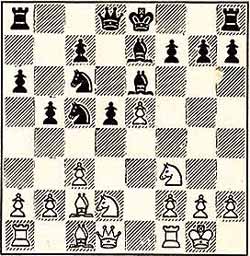|
R A D I O M A T C H R E V I E W E D
|
||
7. MY GAMES WITH LILIENTHAL
by
Albert S. Pinkus |
19 B-B5 Q-R2
19 BxN? . . . .
Here I miss my way. The correct plan was 20 R-QBl in order
to force a decision in the center. If 20 R-QBl, PxP; 21 B-Q2, O-O; 22 Q-N4
with good chances.
20. . . .
PxB A last try to obtain some attack, but Black defends carefully and the position soon drifts into drawish channels.
30 . . . .
RxR
|
|
|
Ruy Lopez A. S. Pinkus
A. Lilienthal 1 P-K4 . . . . Surprise is always a strong psychological weapon, even (or especially?!) In chess, and I was therefore tempted to play 1 P-Q4 rather than my favorite Ruy Lopez. I felt that Lilienthal was all set for a "Lopez" and might have prepared a new line of play. However, in going over some of the games In the recent USSR Championship, I found that Black had had great difficulty in finding a good defense to the “Lopez.” Hence my decision to see what Lilienthal could accomplish against 1 P-K4. 1. . . . P_K4 The Tarrasch Defense is enjoying a great revival in European chess circles. American players generally favor the close variation beginning with 5 ... B-K2. 6 P-Q4 P-QN4 Lilienthal varies from the more
customary 10 ... O-O. His move is not new: I believe it was tried as early
as 1896. In My Chess Career, Capablanca discusses the move at great
length, and in his notes to the game Capablanca-Chajes 11 B-B2 . . . . |
11. . . . B-N5 Although Black's plan Is to force
…P-Q5, the immediate push would lead to sharp play highly unfavorable for
Black: 12 R-K1 Q-Q2 While working on the analysis of this game, it occurred to me that Black can play 12 ... P-Q5-and perhaps "get away with it." The fact that Black's Queen Bishop Is now at KN5 makes all the difference. Hence the move 12 ... P-Q5 deserves careful study.
13 N-B1 R-Q1
This must he played at once, as White is on the point of
exchanging with 19 BxB and then taking the open Queen Bishop file with. 20
QR-B1, after which Black's Queen's Bishop Pawn would be a serious
weakness. |
|
|
||
|
Here I expected the normal 3 N-QB3,
against which I Intended to play Nimzovich's move 3 ... B-N5. Evidently
Lilienthal has too great a respect for this line, as he did not allow me
to play it. Against the text•move Black has a choice between: 3. . . . B-N5ch |
7 P-K4 PxKP White's position still looks imposing but Black's game Is solid. 14 Q-K2 O-O-O The freeing maneuver. 18 PxP BxBP A waiting move which removes the Pawn from attack. White also adopts a waiting policy, so that the game soon drifts into a logically drawn position. |
24 P-KN3 Q-K2 Intending ... N-K1 and ... P-B3 with some prospects or
an attack. If 25 Q-Qlch, K-Kl! (not 25 ... K-B2?; 26 NxP! and If Black
accepts the Knight sacrifice, there follows 27 B-K5ch and 28 Q-R4 mate);
26 Q-R4ch, K-B1 Now White cannot play 27 QxP? because at 27 ... B-K6ch
winning a piece (White's King cannot go to a white square because or 25 B-B2 Drawn Here Lilienthal cabled an offer of a draw, and I saw no reason to refuse, as White still stands better. Continuing to play to the score was or no use, as the match was already lost, and I might even have been In danger of losing the half point which was offered.
|
<Sommario>


